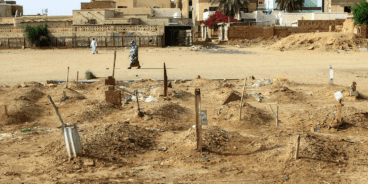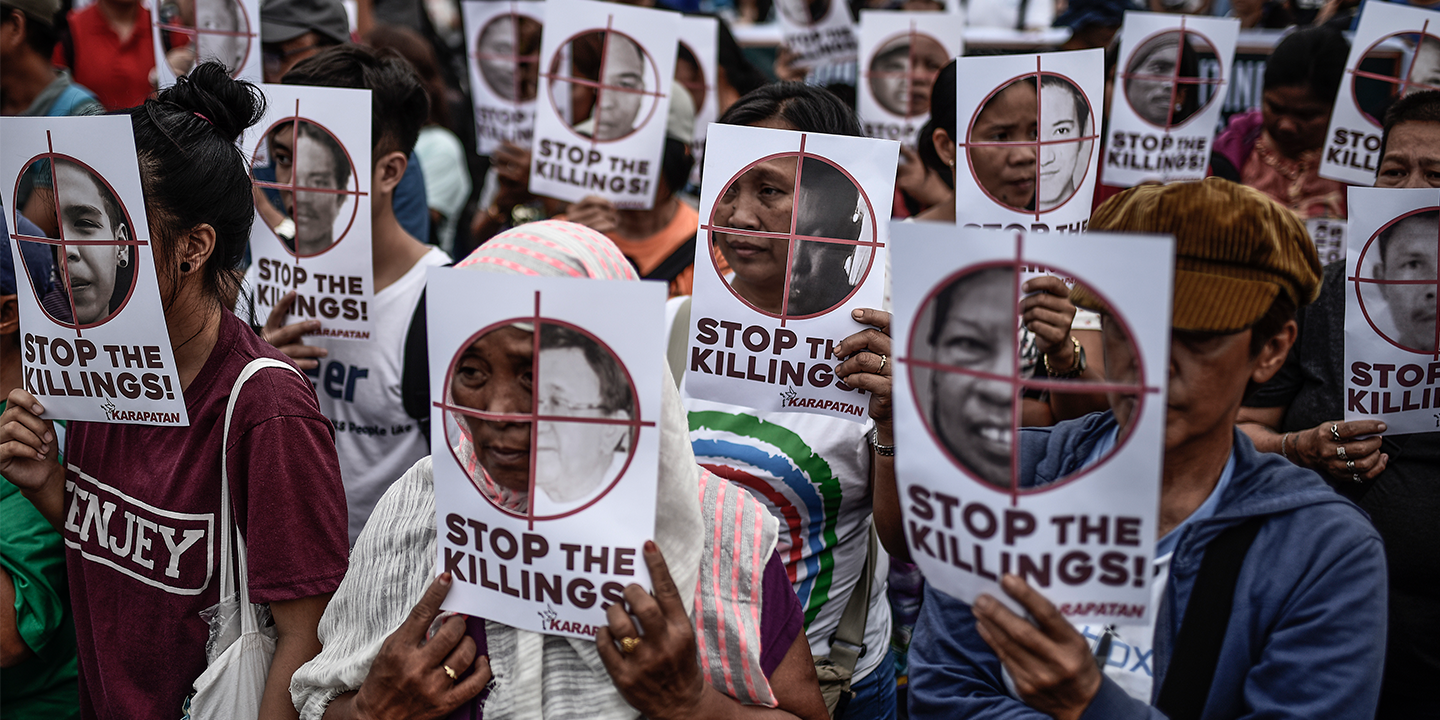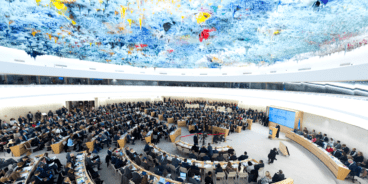

The Relationship Between Violations and Abuses of Human Rights and the Commission of Atrocity Crimes
The Responsibility to Protect is a political commitment made by heads of state and government at the 2005 UN World Summit aimed at preventing and halting four mass atrocity crimes, namely genocide, war crimes, crimes against humanity and ethnic cleansing. In doing so, states agreed that governments have the primary responsibility to protect populations within their borders from atrocity crimes, that the international community should help states in building the capacity to uphold this responsibility, and that when a state is unwilling or manifestly failing to do so, the international community must be prepared to take timely and decisive collective action in accordance with the UN Charter.
Atrocity crimes do not occur in a vacuum, nor are they isolated or random incidents. Rather, they are typically the consequence of a broader process. In order to adequately prevent and respond to the threat of atrocity crimes, there is a need to understand the early warning signs, risk factors and aggravating conditions that may culminate in the perpetration of such grave crimes.
Systematic or widespread human rights violations and abuses often serve as one of the key early warning signs of possible atrocity crimes. This briefing paper aims to examine the relationship between mass atrocity crimes and human rights violations and abuses, highlighting that such violations and abuses may precede and significantly elevate atrocity risks and may also constitute atrocity crimes themselves if certain thresholds or conditions are met.
HUMAN RIGHTS VIOLATIONS AND ABUSES ELEVATE THE RISK OF ATROCITY CRIMES
History has demonstrated that atrocity crimes are often precipitated by serious violations and abuses of human rights by states and non-state actors. Violations of civil and political rights – including the rights to life and liberty, to freedom of movement and of expression, etc. – as well as severe restrictions on economic, social and cultural rights – including the rights to work, to achieve an adequate standard of living, to education, to take part in cultural life, etc. – may create an environment conducive to the commission of atrocity crimes. If states, as well as non-state actors, restrict the space in which populations can practice these rights, it can be an indicator of potential atrocity risks, particularly when paired with other exacerbating factors. For example, when linked to patterns of discrimination or exclusion of protected groups – including ethnic, religious or national minorities, women, children, refugees or internally displaced persons, and others – human rights violations and abuses can create conditions within a society that enable wider targeting of such groups and/or promote identity-based incitement and conflict.
In their Framework of Analysis for Atrocity Crimes, the UN Office on Genocide Prevention and the Responsibility to Protect identifies a “record of serious violations of international human rights and humanitarian law [IHRL and IHL, respectively]” as one of the common risk factors for atrocity crimes.
The Framework of Analysis highlights eight indicators to examine when reflecting on a record of serious violations of IHRL and IHL:
-
- Past or present serious restrictions to or violations of IHRL and IHL, particularly if assuming an early pattern of conduct and if targeting protected groups, populations or individuals.
- Past acts of genocide, crimes against humanity, war crimes or their incitement.
- Policy or practice of impunity for or tolerance of serious violations of IHRL and IHL, of atrocity crimes, or of their incitement.
- Inaction, reluctance or refusal to use all possible means to stop planned, predictable or ongoing serious violations of IHRL and IHL or likely atrocity crimes, or their incitement.
- Continuation of support to groups accused of involvement in serious violations of IHRL and IHL, including atrocity crimes, or failure to condemn their actions.
- Justification, biased accounts or denial of serious violations of IHRL and IHL or atrocity crimes.
- Politicization or absence of reconciliation or transitional justice processes following conflict.
- Widespread mistrust in state institutions or among different groups as a result of impunity.
Human rights violations and abuses occurring in a context with inadequate human rights protection can also elevate atrocity risks. Perpetrators of atrocity crimes require an environment that enables them to mobilize and commit violations without consequence.
Several indicators cited in the Framework of Analysis show how the inability or unwillingness of a state to adhere to international rules and norms surrounding human rights protection may increase the risk of atrocities. This includes:
-
- National legal framework that does not offer ample and effective protection, including through ratification and domestication of relevant IHRL and IHL treaties.
- National institutions, particularly judicial, law enforcement and human rights institutions that lack sufficient resources, adequate representation or training.
- Lack of awareness of and training on IHRL and IHL to military forces, irregular forces and non-state armed groups, or other relevant actors.
- Limited cooperation of the state with international and regional human rights mechanisms.
However, while these indicators are crucial in identifying potential emerging or escalating atrocity risks, they do not necessarily always lead to the commission of atrocities or a significantly elevated risk. Often it is when human rights violations and abuses are paired with other risk factors, such as armed conflicts, limited civic space and high levels of political, social or economic instability that we observe an escalation to atrocity crimes. In recent years, amidst rising nationalism and xenophobia, we have witnessed a simultaneous increase in provocative hate speech and attacks on minorities. In countries that fail to protect the human rights of minorities – either through actively persecuting and discriminating against them or through failing to provide adequate legal protection to all groups within society – the combination of these factors creates an environment conducive to the commission of atrocity crimes.
In Myanmar, for example, decades of structural human rights violations preceded the so-called “clearance operations” of 2017 during which approximately 745,000 Rohingya were forced to flee. Since the 1980s, the Rohingya minority in Myanmar have been systematically stripped of their basic human rights, citizenship and essential services such as health care, education and employment through national laws, including a 1982 citizenship law and the so-called “Protection of Race and Religion” laws adopted in 2015. Such laws created a permissive environment for widespread discrimination, rampant hate speech by prominent religious actors, inter-communal violence and targeting by the security forces. The clearance operations themselves were characterized by brutal acts that amount to genocide, war crimes and crimes against humanity, including indiscriminate killings, rape and sexual violence, arbitrary detention and torture.
By contrast to the Myanmar case, the infringement on women’s rights in Saudi Arabia is institutional and pervasive, including through male guardianship laws, restrictions on freedom of movement and detention for peaceful advocacy. The government of Saudi Arabia consistently represses dissidents, human rights activists and independent clerics, regularly violating the right to freedom of expression, association and belief. Though these clearly constitute serious human rights violations, in the absence of aggravating circumstances or other risk factors such violations have not contributed to the commission of atrocity crimes.
HUMAN RIGHTS VIOLATIONS AND ABUSES MAY CONSTITUTE ATROCITY CRIMES
Many human rights violations and abuses may themselves constitute or amount to an atrocity crime if certain thresholds or conditions are met. Under IHRL states have an extensive set of legal obligations and duties to respect, promote and fulfill human rights. When an act is defined as a human rights violation, it has deprived one or more persons of their fundamental rights and directly contravenes the obligations and duties as set out in the International Covenant on Civil and Political Rights, the International Covenant on Economic, Social and Cultural Rights, the Universal Declaration of Human Rights and numerous other international human rights treaties. Non-state actors can also be bound by the norms and obligations enumerated in these instruments. The extent of their obligations is derived from the nature of their capacity and territorial control.
Crimes against humanity are a set of criminal acts perpetrated as part of a widespread or systematic attack directed against a civilian population. Many serious violations and abuses of human rights – including murder, extermination, rape and sexual violence, torture, arbitrary deprivation of liberty, enslavement, forced disappearance and persecution – may constitute crimes against humanity if they meet the criteria of “widespread” or “systematic.” When a state fails to ensure the protection framework, non-state actors may also commit human rights abuses that amount to atrocity crimes.
In Syria, for example, arbitrary detention has been perpetrated on a widespread and systematic basis by the Syrian government with approximately 130,000 persons arbitrarily detained, abducted or disappeared. The UN Human Rights Council (HRC)-mandated Commission of Inquiry (CoI) on Syria has reported that this amounts to a crime against humanity. Non-state armed groups, including the so-called Islamic State of Iraq and the Levant, Hay’at Tahrir al-Sham, Syrian Democratic Forces, Free Syrian Army and Syrian National Army have also unlawfully deprived individuals of their liberty and have perpetrated widespread and systematic arbitrary detention, enforced disappearance and torture or cruel and degrading treatment.
Certain egregious human rights violations and abuses – when perpetrated with the specific intent to destroy in whole or in part a national, ethnical, racial or religious group – may amount to a constitutive act of genocide.
When perpetrated during times of armed conflict, human rights violations and abuses – including willful killing and torture or inhuman treatment – may also constitute violations of IHL and/or amount to war crimes.
Although the fourth atrocity crime, ethnic cleansing, is not itself an independently defined international crime, the coercive elements that may amount to ethnic cleansing – such as murder, torture, arbitrary detention, extrajudicial executions, rape and sexual violence, and forced displacement or deportation of civilians – are themselves acts that constitute serious violations and abuses of human rights.
THE KEY TO PREVENTION
Effective prevention of mass atrocity crimes can be sustained through identifying and responding to situations at risk of atrocities at an early stage. Given the relationship between human rights violations and abuses and atrocity crimes, atrocity prevention strategies must begin with the protection and promotion of fundamental human rights. This should start with better human rights policies adopted and implemented by states at the national level, including laws that protect minority rights and promote inclusion. When such measures are lacking or failing to curb the behaviors of potential perpetrators, mechanisms created and mandated by the UN in Geneva, as well those at the regional level, are particularly well-suited to identify early warning signs and risk factors which may deteriorate to atrocity crimes.
Various international human rights mechanisms can therefore play a fundamental role in atrocity prevention and in upholding the Responsibility to Protect. International treaty bodies and the Universal Periodic Review process, for example, provide the means to assess individual state performance on implementation of IHRL and provide recommendations on how states can improve the protection of fundamental human rights. UN special procedures – with both thematic and country-specific mandates – can similarly assess individual country performance on human rights, as well as related risks of human rights violations and abuses or of atrocity crimes.
UN mandated investigative mechanisms – including CoIs, Fact-Finding Missions (FFMs) and other bodies – collect evidence of existing human rights violations and abuses while also serving an important early warning function on potential atrocity crimes. Public reports by the Group of Eminent Experts on Yemen and the FFM on Venezuela, for example, outlined possible atrocity crimes while also highlighting factors that created an enabling environment for their commission, including impunity and lack of rule of law. Drawing an even closer connection, the CoI on Burundi and the FFM on Myanmar have used the UN Framework of Analysis for Atrocity Crimes to elaborate upon significant structural risk factors that could potentially result in atrocity crimes, including pervasive human rights violations and fragile state structures. Despite such mechanisms producing clear documentation of potential atrocity crimes, the atrocity prevention lens and assessment of risks has not been systematically included within mandates issued by the HRC.
Regional and subregional organizations have also developed institutions for the protection and promotion of human rights that can be mobilized to prevent or document evidence of atrocity crimes. The African Commission on Human and People’s Rights, an organ of the African Union, for example, issued numerous statements condemning the escalating human rights crisis in Ethiopia during 2020 and 2021 and has its own system of special rapporteurs and thematic working groups that assess national conduct on human rights within their member states. The Organization of American States’ (OAS) Inter-American Commission on Human Rights similarly conducts country visits and issues reports about emerging human rights crises in its member states. The General Secretariat of the OAS has also established various mechanisms to assess atrocity risks and collect evidence of potential atrocity crimes, such as the Panel of Independent International Experts on Venezuela, who in 2018 found reasonable grounds to believe that possible crimes against humanity had taken place since 2014.
CONCLUSION
While not all human rights violations and abuses indicate an imminent atrocity risk, nor do they necessarily directly cause crimes, understanding how they may constitute atrocities or enable their occurrence is an essential step in strengthening the capacity of human rights mechanisms to prevent atrocity crimes.
Understanding the intrinsic link between human rights violations and abuses and atrocity crimes helps clarify the root causes and drivers behind such crimes. However, the opportunities this link provides for more robust and structural atrocity prevention can only be effective if they are properly leveraged. There must be a systematic inclusion of an atrocity prevention lens in all human rights mechanisms, particularly HRC-mandated mechanisms, so that early warning signs and risk factors for atrocity crimes can be identified. This must also be accompanied by increased international will to cooperate with and act on recommendations made by these mechanisms, which requires greater effort to bridge the gap between UN bodies in New York and Geneva, including through inviting Geneva-based mechanisms to brief the UN Security Council.
Related Content


Recommendations for the 49th Session of the Universal Periodic Review
